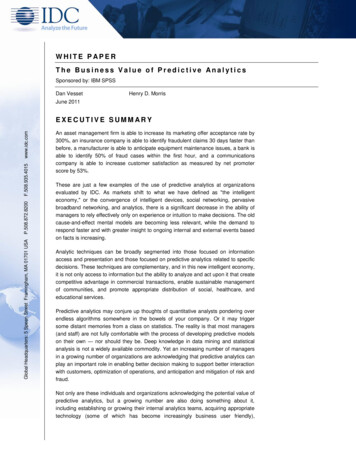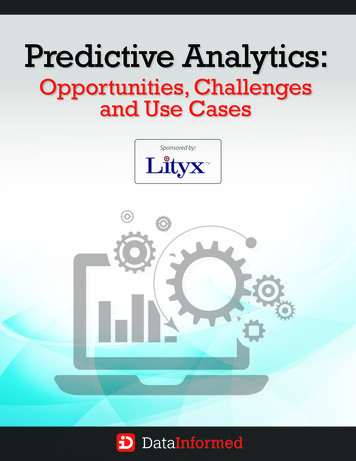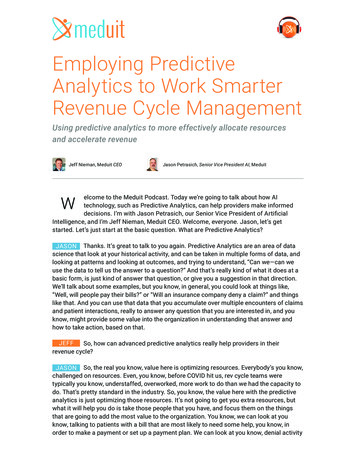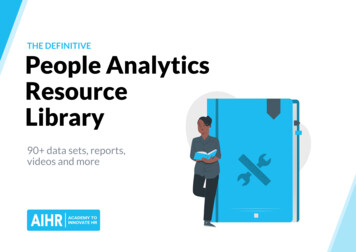
Transcription
Predictive Project Analytics (PPA)Enabling project success through analyticsPredictiveProjectAnalyticsJune 2015
The Project Management Journey1980’s 2nd GenerationDeveloped out ofprofessional PMOrganizations(PMBOK, APM)1950’s 1st GenerationPMBeginning of the modernproject management eraOriginal integration ofproject planning, control& managementMathematical projectscheduling models weredeveloped e.g. CriticalPath MethodProgram Managementprocesses becomedistinct from productprocesses1990’s 2nd Gen SubModelProject Managementdeclared as a corebusiness competency bysenior management.Project Managementprocess partly mixed withtechnical/businessmanagement.Early 2000’sAddress businessissues and pursuit ofinnovation and valuefrom projectsProgram/Project/Portfolio Management structurePresentIntroduction ofanalytics in Project,Program and PortfoliomanagementFocus on executionand low tolerance forfailuresLeverage of projectintelligenceOrganizational PMOmaturity modelOrganizations adoptedheavy methodologiesSupported by globalintranet providing manuals,procedures, tools,templates in all-in-1packageWhere to next?: Questions our clientsare asking us todayWhat is different about projects today?Why analytics now?How do we get better at delivering projects?1Project Predictive Analytics Deloitte LLP and affiliated entities.
PPA’s Value to ProjectsWhat if there was a way to predict and avoid performance strains in projects?42 %of all projects are late,over budget or fail todeliver to specificationsPPA is an analytical project risk management capability thatexamines a project’s characteristics and assesses whether ithas the appropriate level of oversight and governance: Identifies project performance execution shortfalls21%of all projects arecancelled or neverdeployed62%of organizationsexperienced a projectfailure last year Avoids/mitigates execution performance strains and risks Decreases likelihood of schedule overruns Minimizes financial and reputation losses71%need extra timeto deliver – costingorganizations additionaltime and money74 %of project requirementsare actually delivered Provides quantitative and defendable data to drivemanagement decisionsEnsures appropriate project controls are in place to improveproject performance and probability of success.What are the likely impacts of failed projects?Significant cost overruns, operational failures, regulatory noncompliance,customer dissatisfaction, or loss of competitive advantage.2Project Predictive Analytics Deloitte LLP and affiliated entities.
PPA’s Value to Projects (con’t) Objective findings – analytical based findings with quantitative risk data decreasingsubjective element from project reviews Low-impact and high-value - flexible and scalable solution to supplement existing projectmanagement methodologies and control functions Intelligent reporting - analytical based findings with quantitative risk data decreasingsubjective element from project reviews Immediate benefits - improved capital efficiency with tangible ROI for variousstakeholders Approach is based on extensive research - insight into level of manageable projectcomplexity and risk given organization’s current capabilities Comparative analysis – database contains diversity in project size, project type,industries, and geography Transparency - Improved transparency & integration amongst Project Control Functions3Project Predictive Analytics Deloitte LLP and affiliated entities.
PPA Assessment Impact – Construction examplesCapital Project Stage Gate 2 reviews –Conducted project reviews for 5 large capitalprojects ( 25B invested capital) with theobjective of showcasing the value and insightproject analytics provides.IIIIPPA Impact – Provided holisticframework to ensure coverage ofnon-technical risks and identifiedtransformational opportunities toenhance processes and mechanismsto enable value add analysis ofquantitative project data.Initiate/repeat PPAReporting&socializationAnalysis &synthesisGreenfield Landfill ConstructionProject – Develop a scalable, flexible andconsistent Project Assessment methodology.PPA Impact – Developed industry leadinganalytically intelligent approach providing timely,specific, benchmarked, and actionablerecommendations. PPA identified critical systemicissues that included On-sight safety, Contingencymanagement, Safeguarding capital assets, andInappropriate resources & organizational support.4Project Predictive AnalyticsLarge Infrastructure Construction CapitalProject – Assessed a 5B infrastructureproject in the design phase and executionphase for current state of the projectmanagement environment.IIIVInterviews/ structureddocument review 4-6WeeksPPA Impact – Identified nontechnical risks overlooked byengineering procurement, andconstruction managementprocess, quantified risks, &identified overage root causes.Inherentrisk &complexityassessmentConstruction & consolidationproject review - Conductedcurrent state of the project managementenvironment, including relationships betweenkey project management teams.Predictiveanalytic projectreviewPPA Impact – Risk-based assessment wascritical for management providing tangiblerecommendations, including soft factors (e.g.team experience and morale) which improvedthe project’s efficiency and, enhancedlikelihood of success. Deloitte LLP and affiliated entities.
PPA samples5Project Predictive Analytics Deloitte LLP and affiliated entities.
Findings sample: Onsite safety managementDescription The project has a potential health and safety issue due to lack of a full-time [client] on-site presence to oversee contractors executingconstruction at the work site. Although sponsor retains ultimate ownership of the site, and a site specific safety plan has been created, no full-time staff are onsite resulting inH&S compliance resting with third party contractors. Current timelines are aggressive for site handover, which may create increased pressure for contractors to meet schedule commitments. Site is located over fifty miles from sponsor’s office, resulting in significant lag time for resources to access site to manage issues & incidents. [Client] retains ultimate responsibility and liability for incidents on the construction site, and as such, without a full-time on-site resourceoverseeing construction activities, there is a heightened risk exposure and related liability in the event of an H&S incident. This approach is not compliant with H&S standards to report incidents. Emergency response & safety program has been developed in accordance to H&S standards including expected materials such as the FieldRisk Assessment. Responsibility for H&S has been assigned to the Safety Manager. In addition, all team members are on-boarded to the project with the mandatory requirement to complete Health and Safety training. PM and core team make frequent weekly visits to site to oversee construction progress and ensure compliance to XXX H&S standards. 3 Party Engineering firm [name] to be on-site to perform Quality Assurance/Quality Control (‘QA/QC’) for contractors. A corporate standard for H&S oversight on projects of this nature should be defined. Allocation of dedicated resource to manage and provide oversight to contractors operating on site.ImpactProject MitigatingActionsRecommendationrdPPA Supporting Details: Of the PPA execution factors we examined, the following under-performing factors are related to the health and safety finding with additional proposedrecommendations that may improve overall project sources over .21.156Measurement LevelScoreActualExpectedHow are over allocated resources managed?25%Not managedResource loadingHow is resource load managed in theSchedule?33%No resource managementResourceSelectionResource planningWhat resource planning approach is used?40%As needed resourcesAccountabilityModelResource commitmentHow are resourcing issues managed andresolved?50%Ad hoc issue basedEscalated to Steering CommitteePriority managementHow are priorities managed in the Project?50%Priority assigned to the "noise"Priority assigned to the next thing onthe planTeam selectionHow are teams selected?50%Closest to the problemSponsor relationship67%Steering Committee too distantSC operating at the right level ofdetail, but not allowing delegation75%Issue based oversightClear anceApproachAccountabilityModelDelegation of authorityHolding Project ManageraccountableHow well is authority delegated/retained by theSteering Committee?What mechanism is used to hold the ProjectManager accountable?Managed collegially with sponsorsResources force loaded fromrequirementsCore team, with resource schedule fordefined roles Deloitte LLP and affiliated entities.
Findings sample: Contingency ManagementDescriptionImpactProject MitigatingActionsRecommendation At the time of the review, the project contingency remained at the originally approved amount. The project is currently in the process of finalizing an estimated in budgetary changes associated with the contract. These changes are offset by savings in other material quantities, as evidenced by the change request (CR) having no observant or budgetaryimpacts. As a result management anticipates that the contingency will not be affected. While contingency is noted in the AFE, there are no guidelines on a contingency draw down process. Without accurate visibility into project financials and budget status, the newly appointed project sponsors may not have the appropriateinformation to make well-informed decisions. [Client] should ensure that estimating inaccuracies are captured during the lessons learned process to verify where possible project costs,which are used for future estimating, reflect accurate quantities. The current contract is not fixed and is based on estimated volumes and rates. The project team should implement a defined contingency draw down process to provide consistent management of contingency. [Client] should confirm the drawdown thresholds requiring escalation to the steering committee and the Board of Directors.PPA Supporting Details: Of the PPA execution factors we examined, the following under-performing factors are related to the contingency management finding with additional proposedrecommendations that may improve overall project elegated authority of theProject ManagerMeasurement LevelWhat decision rights are delegated to theProject Manager?How are changes to the Project budgetmanaged?Score1.38BudgetsBudget changes1.9GovernanceApproachProject monitoring andcontrol systems1.37Budgets1.36ActualExpectedResource control and budgetallocationsScope and impact evaluation andbudget signoffStandard controls, plus some ad hocsuccess drivers20%No clear delegation - vague25%No approachWhat project controls are in place?40%Intuitive controls, explainable by PMBudget ownershipWho owns and controls the budget?50%Executive with drip feedSC with scope controlBudgetsBudget controlHow is the Project budget controlled?60%Budget with end reconciliationActuals accurate and timely, forecastis estimated2.3ExecutiveSupportExecutive engagement75%Issue basedSteering Committee attendance3.43PlanningContingency planning75%Simple plan on paperSimple project plan6.13ContingencyContingency riskmanagement75%Ad hoc as neededDocumented and tracked1.137What level of Executive engagement does theProject have?How are plans to address contingencycreated?How are contingency plans prepared and usedto manage risk? Deloitte LLP and affiliated entities.
PPA Visualization and Dashboards8Project Predictive Analytics Deloitte LLP and affiliated entities.
Reporting Results & VisualizationSAMPLE REPORTING DASHBOARDSComplexity SummaryProject Performance Summary Average projectcomplexity is 6.5 Multi disciplinary team Requires boardattentionComplexity DetailsProject Controls Summary% of factors outside of expected resultsBelowAboveGovernance23%Ownership7%Delivery Management13%Business Unit25%Resource Management 0%Risk Management50%Contracting Approach21%21%0%26%25%14%0%21%Summary AnalysisActual vs. expected project practices for the project is 100%which is within the range of expected success, however therewere key areas that showed controls/performance below what isexpected.9Project Predictive Analytics Deloitte LLP and affiliated entities.
Reporting Results & Visualization – Program LevelADDITIONAL PPA REPORTING DASHBOARDSPerformance Cliff Analysis Understand at what level ofcomplexity projects begin to decreasein effective execution within anorganization. Leverage existing data to uncoverorganizational project managementcapability strengths and weaknesses.Complexity Distribution of ProjectPortfolioProject Performance Comparison Provide additional insight in projectprioritization and fiscal planning. Identify systemic issues within projectexecution and management. Better manage risk levels related tocomplexity across portfolio projects. Identify areas that are consistentlyover controlled . Enable risk balanced adjustments tomaximize capital efficiency.Explore the data you have Reveal better Insight Ask new questions10Project Predictive Analytics Deloitte LLP and affiliated entities.
Risk Assessment Heat Map1.2.3.4.5.Governance and OwnershipRisk ManagementDelivery ManagementResource ManagementVendor Contract & RelationshipManagement6. Change Management /Business Unit ImpactNext Generation Risk Assessment Heat Map545ImpactRisk Category:Minimal/NoChange3132326Movement of risk classificationShift betweenDate 1 & Date 2544621Velocity (risk manifestation):SlowMedium1Fast2345LikelihoodRisk FactorLow1-5Medium6-10High11-1611 Project Predictive AnalyticsVery High17-25 Deloitte LLP and affiliated entities.
12 Project Predictive Analytics Deloitte LLP and affiliated entities.
13 Project Predictive Analytics Deloitte LLP and affiliated entities.
14 Project Predictive Analytics Deloitte LLP and affiliated entities.
PPA Process15Project Predictive Analytics Deloitte LLP and affiliated entities.
PPA OverviewA project risk management methodology based on a quantitative analytical engine.Navigator Project ing & PlanningRelationship Mgmt 3rd Party NetworkBusinessDevelopmentNew Product DevelopmentStrategy & PlanningRisk Assessment/Health CheckE BasedG BasedOther RelatedFunctions / Orgs.Location WLocation XLocation YLocation ZRetailerBusiness DevelopmentTrainingComplexity AssessmentMarketingCall CentreApplication tionsVALUECHAINFraudSALES &SERVICEMerchant SupportMerchant RecordsOperational AccountingCard RewardsSupplier ManagementGlasgow OPDProgramme / Change ManagementOperational RiskMerchant LiaisonOPD IssuingSUPPORTFUNCTIONSAND ACTIVITIESManagement InformationBusiness Intel igenceCentral SupportBusiness AnalysisCompliance and ContinuityFinanceOTHERRELATEDFUNCTIONSOperational FinanceOPD AcquiringRiskBusiness DevelopmentHelpdeskCard RiskLondon Function XFunction YFunction XCards ITAcquisition FinanceCard AdminMajor Programmes DeliveryDatabase contains over2,000 successfullycompleted projects fromvarious industries,sizes, complexities andmagnitude ranging upto US 5B28 complexity factors,within 5 areas, arebased on research thathas identified the keycharacteristics thatdrive complexity on allprojectsComprehensiveassessment of projectperformance and useanalytics to highlightpriority areas forimprovement based onthe project’s uniquecomplexityAnalytical tool with “Big Data” capabilitiesPPA provides insights derived from systemic, scientific, and statisticallysignificant methodologies allowing for evidence based decision making.16 Project Predictive Analytics Deloitte LLP and affiliated entities.
Navigator TIONE BasedG BasedOther RelatedFunctions / Orgs.Location WLocation XLocation YLocation ZRetailerBusiness DevelopmentTrainingMarketing & PlanningRelationship Mgmt 3rd Party NetworkBusinessDevelopmentNew Product DevelopmentStrategy & PlanningMarketingCall Centre Over 2,000 successful* projects; range US 1M - 5BApplication tionsVALUECHAINFraudSALES &SERVICEMerchant Support Developed through years of research employing:Merchant RecordsOperational AccountingCard RewardsSupplier ManagementGlasgow OPDProgramme / Change ManagementOperational RiskMerchant LiaisonOPD IssuingSUPPORTFUNCTIONSAND ACTIVITIES– scientific methodologies of problem disaggregationManagement InformationCentral SupportBusiness AnalysisCompliance and ContinuityFinanceOTHERRELATEDFUNCTIONSOperational FinanceOPD AcquiringRiskBusiness Intel igenceBusiness DevelopmentHelpdeskCard RiskLondon Function XFunction YFunction XCards ITAcquisition FinanceCard AdminMajor Programmes Delivery– field and hypothesis testing– statistical modelingThe logic behind the algorithm Statistically derived correlations between each complexity factorand each control factor Correlation table contains statistically derivedcorrelations between each complexity factorand each control factor.What makes up the PPA database?20% Inference engine assembles in real time aprobability curve one control at a time.10%10%40%30%60% It does this by looking up the correlationweight from the table for the currentcomplexity factor for the current control factorand adding that correlation to the associatedbin that matches the complexity score. Correlation weight for each complexity factoris loaded into the probability curve until all arecompleted.30%Industry ViewFinancial ServicesTelecommunications Inference engine uses a correlation table tocreate a probability distribution curve for theexpected controls/ performanceEnergy &defenseOther Probability mean is then calculated from theProject Typesdistribution of probabilities across bins.IT & business processPublic sector infrastructure & engineering The score is then de-normalized back to therange of the control and the score loaded intoOtherthe expected data set.* Success is defined as on time, on budget, and met all objectives17 Project Predictive Analytics Deloitte LLP and affiliated entities.
Complexity AssessmentOVERVIEW OF COMPLEXITY CHARACTERISTICSUnique Project Complexity Profile 250MM possible permutations ofunique project complexity profilesThe first stage of the reviewassesses the complexity ofthe project against apredefined set of inherentrisk categories. Complexityis measured across 28factors in five categories.Areas thatincreases overallcomplexityaverage, requireenhancedgovernanceFactor thatreduces overallcomplexity (e.g.areas that areroutine for thespecific project)Theaveragelevel ofcomplexityacross allfactorsFor the level of complexity determined in stage one, an expected level of projectoversight/governance is generated using predictive project analysis.18 Project Predictive Analytics Deloitte LLP and affiliated entities.
Risk Assessment / Health Check172 FACTORS FOR CONSISTENTLY MEASURING PROJECT PERFORMANCEBased on project complexity, the AnalyticalEngine determines the level of executionperformance control necessary to achievesuccess.Of concernUnderperformingAs expected,acceptable rangefor successOverinvestment Capability could be used in conjunction withother complexity assessments Enhances current process to analyze aproject(s) Benchmarks the project against projects of asimilar complexity profiles Indicates whether overall level of projectcontrols are above/below expectations and ifthey resemble projects that went on to besuccessful Identifies areas of over investmentAssesses project execution practices across 7business domains 7 domains are subdivided into 27 categories formore detailed analysis Supported by 172 individual performanceexecution characteristics Characteristics considered critical to driveproject success.by the research institute andDeloitte.19 Project Predictive Analytics Deloitte LLP and affiliated entities.
Risk Assessment / Health Check172 FACTORS FOR CONSISTENTLY MEASURING PROJECT PERFORMANCEBased on project complexity, the AnalyticalEngine determines the level of executionperformance control necessary to achievesuccess.Of concernUnderperformingAs expected,acceptable range forsuccessOverinvestment Capability could be used in conjunction withother complexity assessments Enhances current process to analyze aproject(s) Benchmarks the project against projects of asimilar complexity profiles Indicates whether overall level of projectcontrols are above/below expectations and ifthey resemble projects that went on to besuccessful Identifies areas of over investmentAssesses project execution practices across 7business domains 7 domains are subdivided into 27 categories formore detailed analysis Supported by 172 individual performanceexecution characteristics Characteristics considered critical to driveproject success.by the research institute andDeloitte.20 Project Predictive Analytics Deloitte LLP and affiliated entities.
Drill Down – Risk Management DomainWhat approach is used to plan for the challenges ofrapidly developing technology? NoneTechnical Evolution ManagementRapidly evolving technologies create particular risk for projects, especiallywhere the development of the technology is outside the control of the Projectand developments are likely within the life of the Project. The approach usedby the Project to plan for these risks should be based on the potential impacton the Project and breadth of possible technology developments.What approach is used to plan for the challenges of rapidlydeveloping technology?Actual Level of Control Simple Risk Analysis21 Project Predictive AnalyticsExpected Level of control Simple scenarioplanning and patternmatching against similartechnology paths Simple risk analysis Advanced risk analysis Simple assumption testing and design sensitivity modelingat start Advanced assumption testing and design sensitivitymodeling at start Simple assumption testing and design sensitivity modelingand tracking Advanced assumption testing and design sensitivitymodeling and tracking Simple scenario planning and pattern matching againstsimilar technology paths Advanced scenario planning and pattern matching againstsimilar technology paths Deloitte LLP and affiliated entities.
Drill Down – Governance DomainHow are priorities managed in the Project? No priority management all issues equally important Priority assigned to the "noise" Priority assigned to the next thing ready to be done Priority assigned to the next thing on the plan Priority assigned to intuitive critical path Priority assigned to the calculated critical path Priority assigned to the calculated critical path andelements at risk of becoming critical pathIssue prioritizationHow are issues prioritized?Actual Level of Control 22Project Predictive AnalyticsWhatever is "noisy"Expected Level of control Risk-based issue priority Deloitte LLP and affiliated entities.
Review Methodology and timelineThe Project Review team uses a structured approach and methodology to accelerate informationgathering and data analysis. This approach paired with the analytical algorithm delivers detailed andtailored recommendations over an extensive selection of critical project areas in an condensed timeline.PPA Review Methodology (4-6 weeks)Interviews &Document ReviewActivities Develop anunderstanding of theproject and organization Interviews with coreproject team membersComplexityAssessmentProject ExecutionAssessment Perform a ProjectComplexity Assessmentto understand theproject’s uniquecomplexity profile Assess projectexecution performanceusing Predictive Analyticcapability and CapitalProject SME inputs. Interviews with keystakeholdersKey Outputs23 Analyze output frominterviews, documentreview and predictiveanalytic toolReporting Deliver findings ofreview Identify prioritizedrecommended actions Develop broad and deepview of the keyunmitigated project risks Identify controlimprovements mostcorrelated with asuccessful outcome Detailed review of coredocuments (e.g. plans,reports and logs) Develop anunderstanding of theproject and organizationAnalysis andSynthesis Detailed ProjectComplexity Profile withdocumented project riskdrivers.Project Predictive Analytics Actual vs. Expectedlevels of performanceacross 7 businessdomains. Detailed findings theidentification of themes,systemic project issuesand root causes ofproject challenges. Recommendations forimprovement and finalreport. Deloitte LLP and affiliated entities.
PPA Case Studies“Deloitte is consistently working toward finding and producing new RiskManagement solutions, using analytics to help clients solve complex riskproblems. The latest example is the Project Predictive Analytics tool,which applies risk analytics to large projects and internal audit planningand offers a risk-sensing analytics solution.”Source: Gartner - MarketScope for Global Risk Management Consulting Services 2013 PPA has assessed over US 100 billion in invested capital! Deloitte LLP and affiliated entities.
A snapshot of industry case studiesOIL & GAS - Deloitte was engaged to complete retrospective project reviews on 5 large Capital Projects to define complexitylevels and expected project performance. The PPA capability for review demonstrated the power of quantitative risk data and itsability to provide a foundation for an analytically driven project management framework. PPA partnered with a One Deloitte crossfunctional team for future phases, will support its continued journey to enable world class project planning and risk intelligentprocess improvementTRANSPORTATION - Working with Internal Audit, Deloitte was engaged to review a large IT implementation project early in theexecution phase. The objective of the review was to identify enhancements to planned project management activities to improveperformance and set this critical project up for success. The PPA review framework evaluated the project across a broad spectrumof execution areas, which allowed Internal Audit to thoroughly cover all key areas of potential project risk. Furthermore, the use ofPPA will enable efficient and effective reviews by leveraging the baseline assessment throughout the project phases and throughgo-live.DEFENSE - Conducted a proof-of-concept pilot to demonstrate that PPA could predict the issues that ultimately affected thesuccess of a key defense project. The PPA diagnostic capability accurately identified program management factors thatcontributed to the termination of the project PPA is an applicable diagnostic capability within the defense industry predicting areaslacking the appropriate controls, thereby identifying risks to project successBANKING - After a successful pilot of PPA a bank implemented a managed service arrangement with Deloitte to have PPA replaceits existing project audit methodology. The revised approach for projects allowed the bank to conduct a larger number of projectreviews, offer more value, increase risk coverage , add insights and timely recommendations, report consistently, and help improveoverall project practices at the bank.ASSET MANAGEMENT - Deloitte was engaged to provide Project Risk Advisory Services for a core pension systemreplacement. As part of our advisory role, PPA was utilized to provide the steering committee and executives with enhancedawareness of project complexity drivers and risk data to support project management decisions. PPA provided the project teamwith a project specific benchmark of expected levels of controls to manage against through the full project lifecycle and topromote more effective project planning.25Project Predictive Analytics Deloitte & Touche LLP and affiliated entities.
PPA Framework26Project Predictive Analytics Deloitte & Touche LLP and affiliated entities.
Assessing project complexity-the factors27 Project Predictive Analytics Deloitte & Touche LLP and affiliated entities.
PPA ApproachLink between complexity and project execution performanceEach of the three projects reviewed had a different level of complexity and, therefore, required different levels ofproject management execution in order to achieve success.Project 1Project 2Project 3Complexity summaryComplexity summaryComplexity summaryProject 1Project 2Project 3Complexity detailsComplexity detailsComplexity details28Project Predictive Analytics Deloitte & Touche LLP and affiliated entities.
Measuring Project Performance7 KEY AREAS AND 27 SUB GROUPSPPA provides coverage across key areas of program management, which through research are found to bestatistically significant control points linked to project performance.1. GovernanceRole ManagementGovernance ApproachBenefits ManagementIssue ManagementBudgetAccountability Model2. Ownership3. Organization4. ContractingDirectionOrganization ImpactVendor ManagementExecutive SupportOrganization SupportContracting Approach5. Delivery ManagementStakeholder ManagementDesignSchedulingPlanningManaging UncertaintyDeliveryAcceptance Model6. ResourcingSkills & ExperienceResource SelectionResource CommitmentPerformance Management7. Risk ManagementTechnical Risk29Project Predictive AnalyticsManagement of RiskContingencyApproach to Risk Deloitte LLP and affiliated entities.
Assessing project execution-factors30 Project Predictive Analytics Deloitte LLP and affiliated entities.
PPA Portal31Project Predictive Analytics Deloitte LLP and affiliated entities.
PPA Portal As part of our deployment scenarios, we have created and can customize a secure Portal solely for a specific clients The Portal allows the client to submit complexity and detailed project data; as needed These will be assessed by the Deloitte PPA team and ana
Project Predictive Analytics . Capital Project Stage Gate 2 reviews – Conducted . project reviews for 5 large capital projects ( 25B invested capital) with the objective of showcasing the value and insight project analytics provides. PPA Impact – Provided holistic . framework t










